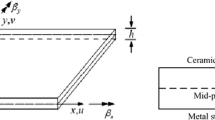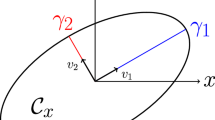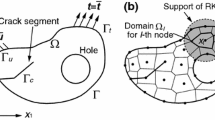Abstract
In contrast to classical elasticity, the micropolar continuum theory allows to describe materials with significant microstructural effects, such as particulate, granular and porous composites. Such materials show a size effect and have often a spatially varying distribution of mechanical properties. This contribution focuses on the establishment of the interaction integral (I-integral) for decoupling the force stress intensity factors (FSIFs) and couple stress intensity factors (CSIFs) of a crack in functionally graded micropolar material (FGMM). The I-integral is derived from the J-integral by superimposing an auxiliary field on the actual field. The auxiliary field is examined using three different definitions including the constant-constitutive-tensor (CCT) formulation, the non-equilibrium (NE) formulation and the incompatibility (IC) formulation. The NE and IC formulations are more appropriate than the CCT formulation because the I-integral using the CCT formulation involves strain gradients and curvature gradients, which may cause loss of accuracy in numerical calculations. Furthermore, we introduce the patched extended finite element method (patched-XFEM), which replaces crack-tip enrichment functions from the XFEM by a local refined mesh to improve the numerical precision. The I-integral in combination with the patched-XFEM is employed to examine numerically the influence of material parameters on the FSIFs and CSIFs.
Access this chapter
Tax calculation will be finalised at checkout
Purchases are for personal use only
Similar content being viewed by others
References
Eremeyev, V.A., Lebedev, L.P., Altenbach, H.: Foundations of Micropolar Mechanics. Springer, Berlin (2013)
Karlis, G.F., Tsinopoulos, S.V., Polyzos, D., Beskos, D.E.: Boundary element analysis of mode I and mixed mode (I and II) crack problems of 2-D gradient elasticity. Comput. Methods Appl. Mech. Eng. 196, 5092–5103 (2007)
Trovalusci, P., Ostoja-Starzewski, M., DeBellis, M.L.: Scale-dependent homogenization of random composites as micropolar continua. Eur. J. Mech. A Solids 49, 396–407 (2015)
Cosserat, E., Cosserat, F.: Theories des Corps Deformables. Hermann et Fils, Paris (1909)
Eringen, A.C.: Linear theory of micropolar elasticity. J. Math. Mech. 15, 909–923 (1966)
Eringen, A.C.: In: Liebowitz, H. (ed.) Theory of Micropolar Elasticity (in Fracture). Academic Press, New York (1968)
Cowin, S.C.: Stress functions for Cosserat elasticity. Int. J. Solids Struct. 6, 389–398 (1970)
Gauthier, R.D., Jahsman, W.E.: A quest for micropolar elastic constants. J. Appl. Mech. 42, 369–374 (1975)
Yang, J.F.C., Lakes, R.S.: Experimental study of micropolar and couple stress elasticity in compact bone in bending. J. Biomech. 15, 91–98 (1982)
Lakes, R.S.: Size effects and micromechanics of a porous solid. J. Mater. Sci. 18, 2572–2580 (1983)
Lakes, R.S.: Experimental microelasticity of two porous solids. Int. J. Solids Struct. 22, 55–63 (1986)
Lakes, R.S.: Experimental methods for study of Cosserat elastic solids and other generalized elastic continua. Wiley, New York (1995)
Lakes, R.S.: On the torsional properties of single osteons. J. Biomech. 28, 1409–1410 (1995)
Sternberg, E., Muki, R.: The effect of couple-stresses on the stress concentration around a crack. Int. J. Solids Struct. 36(1), 69–95 (1967)
Atkinson, C., Leppington, F.G.: Some calculations of the energy-release rate G for cracks in micropolar and couple-stress elastic media. Int. J. Fract. 10, 599–602 (1974)
Paul, H.S., Sridharan, K.: The penny-shaped crack problem in micropolar elasticity. Int. J. Eng. Sci. 18, 651–664 (1980)
Paul, H.S., Sridharan, K.: The problem of a Griffith crack in micropolar elasticity. Int. J. Eng. Sci. 19, 563–579 (1981)
Sridharan, K.: The micropolar thermoelastic problem of uniform heat-flow interrupted by an insulated penny-shaped crack. Int. J. Eng. Sci. 21, 1459–1469 (1983)
Diegele, E., Elsaber, R., Tsakmakis, C.: Linear micropolar elastic crack-tip fields under mixed mode loading conditions. Int. J. Fract. 129, 309–339 (2004)
Yavari, A., Sarkani, S., Moyer, E.T.: On fractal cracks in micropolar elastic solids. J. Appl. Mech. 69, 45–54 (2002)
Midya, G.K., Layek, G.C., De, T.K.: On diffraction of normally incident SH-waves by a line crack in micropolar elastic medium. Int. J. Solids Struct. 44, 4092–4109 (2007)
Warren, W.E., Byskov, E.: A general solution to some plane problems of micropolar elasticity. Eur. J. Mech. A Solids 27, 18–27 (2008)
Li, Y.D., Lee, K.Y.: Fracture analysis in micropolar elasticity: mode-I crack. Int. J. Fract. 156, 179–184 (2009)
Antipov, Y.A.: Weight functions of a crack in a two-dimensional micropolar solid. Q. J. Mech. Appl. Math. 65, 239–271 (2012)
Piccolroaz, A., Mishuris, G., Radi, E.: Mode III interfacial crack in the presence of couple-stress elastic materials. Eng. Fract. Mech. 80, 60–71 (2012)
Kennedy, T.C.: Modeling failure in notched plates with micropolar strain softening. Compos. Struct. 44, 71–79 (1999)
Dillard, T., Forest, S., Ienny, P.: Micromorphic continuum modelling of the deformation and fracture behaviour of nickel foams. Eur. J. Mech. A Solids 25, 526–549 (2006)
Shmoylova, E., Potapenko, S., Rothenburg, L.: Boundary element analysis of stress distribution around a crack in plane micropolar elasticity. Int. J. Eng. Sci. 45, 199–209 (2007)
Atoshchenko, E., Bordas, S.P.A.: Fundamental solutions and dual boundary methods for fracture in plane Cosserat elasticity. Proc. R. Soc. A 471, 20150216 (2015)
Khoei, A.R., Karimi, K.: An enriched-FEM model for simulation of localization phenomenon in Cosserat continuum theory. Comput. Mater. Sci. 44, 733–749 (2008)
Kapiturova, M., Gracie, R., Potapenko, S.: Simulation of cracks in a Cosserat medium using the extended finite element method. Math. Mech. Solids 21(5), 621–635 (2016)
Jaric, J.: The energy release rate and the J-integral in nonlocal micropolar field theory. Int. J. Eng. Sci. 28, 1303–1313 (1990)
Yu, H.J., Sumigawa, T., Kitamura, T.: A domain-independent interaction integral for linear elastic fracture analysis of micropolar materials. Mech. Mater. 74, 1–13 (2014)
Stern, M., Becker, E.B., Dunham, R.S.: A contour integral computation of mixed-mode stress intensity factors. Int. J. Fract. 12, 359–368 (1976)
Kfouri, A.P.: Some evaluations of the elastic T-term using Eshelby’s method. Int. J. Fract. 30, 301–315 (1986)
Dolbow, J.E., Gosz, M.: On the computation of mixed-mode stress intensity factors in functionally graded materials. Int. J. Solids Struct. 39, 2557–2574 (2002)
Kim, J.H., Paulino, G.H.: Consistent formulations of the interaction integral method for fracture of functionally graded materials. J. Appl. Mech. T ASME 72, 351–364 (2005)
Guo, L.C., Noda, N.: Modeling method for a crack problem of functionally graded materials with arbitrary properties-piecewise-exponential Model. Int. J. Solids Struct. 44(21), 6768–6790 (2007)
Guo, L.C., Wang, Z.H., Noda, N.: A fracture mechanics model for a crack problem of functionally graded materials with stochastic mechanical properties. Proc. R. Soc. A 468, 2939–2961 (2012)
Yu, H.J., Wu, L.Z., Guo, L.C., Du, S.Y., He, Q.L.: Investigation of mixed-mode stress intensity factors for nonhomogeneous materials using an interaction integral method. Int. J. Solids Struct. 46, 3710–3724 (2009)
Yu, H.J., Wu, L.Z., Guo, L.C., He, Q.L., Du, S.Y.: Interaction integral method for the interfacial fracture problems of two nonhomogeneous materials. Mech. Mater. 42, 435–450 (2010)
Pathak, H., Singh, A., Singh, I.V.: Numerical simulation of bi-material interfacial cracks using EFGM and XFEM. Int. J. Mech. Mater. Des. 8, 9–36 (2012)
Bhattacharya, S., Singh, I.V., Mishra, B.K., Bui, T.Q.: Fatigue crack growth simulations of interfacial cracks in bi-layered FGMs using XFEM. Comput. Mech. 52, 799–814 (2013)
Cahill, L.M.A., Natarajan, S., Bordas, S.P.A., O’Higgins, R.M., McCarthy, C.T.: An experimental/numerical investigation into the main driving force for crack propagation in uni-directional fibre-reinforced composite laminae. Compos. Struct. 107, 119–130 (2014)
Yu, H.J., Sumigawa, T., Wu, L.Z., Kitamura, T.: Generalized domain-independent interaction integral for solving the stress intensity factors of nonhomogeneous materials. Int. J. Solids Struct. 67–68, 151–168 (2015)
Lakes, R.S., Benedict, R.L.: Noncentrosymmetry in micropolar elasticity. Int. J. Eng. Sci. 20, 1161–1167 (1982)
Neff, P., Ghiba, I.D., Madeo, A., Placidi, L., Rosi, G.: A unifying perspective: the relaxed linear micromorphic continuum. Contin. Mech. Thermodyn. 26, 639–681 (2014)
Steinmann, P., Willam, K.: Localization within the framework of micropolar elasto-plasticity. Adv. Contin. Mech. 296–313 (1991)
Eischen, J.W.: Fracture of nonhomogeneous materials. Int. J. Fract. 34, 3–22 (1987)
Jin, Z.H., Noda, N.: Crack-tip singular fields in nonhomogeneous materials. J. Appl. Mech. 61, 738–740 (1994)
Lubarda, V.A., Markenscoff, X.: On conservation integrals in micropolar elasticity. Philos. Mag. 83, 1365–1377 (2003)
Rao, B.N., Kuna, M.: Interaction integrals for fracture analysis of functionally graded piezoelectric materials. Int. J. Solids Struct. 45(20), 5237–5257 (2008)
Rao, B.N., Kuna, M.: Interaction integrals for fracture analysis of functionally graded magnetoelectroelastic materials. Int. J. Fract. 153(1), 15–37 (2008)
Moës, N., Dolbow, J., Belytschko, T.: A finite element method for crack growth without remeshing. Int. J. Numer. Methods Eng. 46, 131–150 (1999)
Brown, W.F., Srawley, J.E.: Plane strain crack toughness testing of high strength metallic materials. ASTM STP 410, 12 (1966)
Acknowledgements
The work was financially supported by the National Natural Science Foundation of China (Grant No. 11772105 and 11472191) and by the Alexander von Humboldt Foundation.
Author information
Authors and Affiliations
Corresponding author
Editor information
Editors and Affiliations
Rights and permissions
Copyright information
© 2018 Springer International Publishing AG
About this chapter
Cite this chapter
Yu, H., Kuna, M. (2018). A J-Interaction Integral to Compute Force Stress and Couple Stress Intensity Factors for Cracks in Functionally Graded Micropolar Materials. In: Altenbach, H., Jablonski, F., Müller, W., Naumenko, K., Schneider, P. (eds) Advances in Mechanics of Materials and Structural Analysis. Advanced Structured Materials, vol 80. Springer, Cham. https://doi.org/10.1007/978-3-319-70563-7_19
Download citation
DOI: https://doi.org/10.1007/978-3-319-70563-7_19
Published:
Publisher Name: Springer, Cham
Print ISBN: 978-3-319-70562-0
Online ISBN: 978-3-319-70563-7
eBook Packages: EngineeringEngineering (R0)




